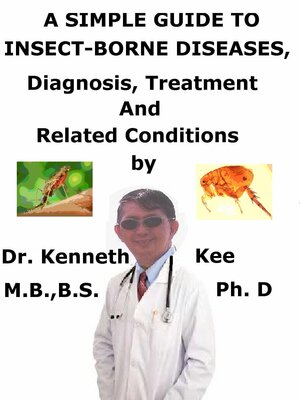A Simple Guide to Insect-Borne Diseases, Diagnosis, Treatment and Related Conditions
ebook
By Kenneth Kee

Sign up to save your library
With an OverDrive account, you can save your favorite libraries for at-a-glance information about availability. Find out more about OverDrive accounts.
Find this title in Libby, the library reading app by OverDrive.



Search for a digital library with this title
Title found at these libraries:
| Library Name | Distance |
|---|---|
| Loading... |
Different insects can produce severe diseases that can cause death such as dengue hemorrhagic fever, malaria especially in children, fetal deaths in zika infected pregnant women, and the Black Death (plague) in the middle ages.
Insect-borne diseases are viral and bacterial diseases from insect bites.
The most frequent insects that transmit disease are mosquitoes, sand flies, ticks, and fleas.
Mosquitoes are famous for spreading the Dengue virus, Zika virus, Chikungunya virus, Yellow Fever, and Malaria.
Aedes
1. Chikungunya
2. Dengue
3. Lymphatic filariasis
4. Rift Valley fever
5. Yellow Fever
6. Zika
Anopheles
1. Lymphatic filariasis
2. Malaria
Culex
1. Japanese encephalitis
2. Lymphatic filariasis
3. West Nile fever
Ticks are famous for spreading Lyme disease and Rocky Mountain spotted fever.
1. Lyme disease
2. Rocky Mountain spotted fever
3. Crimean-Congo haemorrhagic fever
4. Relapsing fever (borreliosis)
Fleas are famous for spreading the Bubonic Plaque (Black Death) to humans in the middle ages
1. Plague (transmitted from rats to humans)
Lice are common in unhygienic people who do not shower and wear dirty unhealthy clothing.
1. Typhus
Sandflies tend to bite people at beaches.
1. Leishmaniasis
Tsetse fly can transmit trypanosomes to humans through its bite causing Sleeping Sickness
1. Sleeping sickness
Chagas disease, a leading cause of cardiomyopathy in the world is spread by kissing bugs.
1. Chagas disease
The diseases are produced by blood-sucking insects that infect humans when they bite the person.
The patient increases the danger of being infected by an insect when the patient is in areas where they gather.
This environment would involve tall grass, bushes, spots near still water (ponds), beaches and places around the globe with heavy outbreaks.
Symptoms will differ depending upon the type of insect that bit the person:
1. Fever
2. Chills
3. Headache
5. Sore muscles
6. Skin rash
7. Nausea
8. Abdominal pain
More serious symptoms can be:
1. Difficulty breathing
2. The feeling that the throat is closing
3. Swelling of the lips, tongue or the face
4. Chest pain
5. A racing heartbeat that lasts more than a few minutes
6. Dizziness
7. Vomiting
The doctor can normally diagnose an insect-borne disease with a physical examination, a review of the symptoms, and the history of the recent travel.
Laboratory tests (blood and urine) can assist in diagnosing certain insect-borne diseases.
As soon as the patient recognizes a bite, he or she should clean it with soap and water.
The patient should pat it dry and apply rubbing alcohol.
If the patient was bitten by a tick, he or she should remove the tick away before cleaning the area.
The patient should use tweezers to slowly pull it off the skin.
The patient should be careful not to leave any part of the tick on the skin.
The patient should wash the hands and the bite area with soap and water and wipe with alcohol.
The patient should apply an over-the-counter antibiotic cream to the bite area.
If the patient has any of the symptoms above, he or she should see the doctor.
The doctor may give the patient a prescription for antibiotic medicine.
The over-the-counter pain medicine can alleviate sore muscles and a fever.
Death in insect-borne diseases happens in dengue fever, malaria, zika (fetus) and plague.
TABLE OF CONTENT
Introduction
Chapter 1 Insect-borne Diseases







